24-cell
In four-dimensional geometry, the 24-cell is the convex regular 4-polytope[1] with Schläfli symbol {3,4,3}. It is also called C24, or the icositetrachoron,[2] octaplex (short for "octahedral complex"), icosatetrahedroid,[3] octacube, hyper-diamond or polyoctahedron, being constructed of octahedral cells.
| 24-cell | |
|---|---|
 Schlegel diagram (vertices and edges) | |
| Type | Convex regular 4-polytope |
| Schläfli symbol | {3,4,3} r{3,3,4} = {31,1,1} = |
| Coxeter diagram | |
| Cells | 24 {3,4} |
| Faces | 96 {3} |
| Edges | 96 |
| Vertices | 24 |
| Vertex figure | Cube |
| Petrie polygon | dodecagon |
| Coxeter group | F4, [3,4,3], order 1152 B4, [4,3,3], order 384 D4, [31,1,1], order 192 |
| Dual | Self-dual |
| Properties | convex, isogonal, isotoxal, isohedral |
| Uniform index | 22 |
The boundary of the 24-cell is composed of 24 octahedral cells with six meeting at each vertex, and three at each edge. Together they have 96 triangular faces, 96 edges, and 24 vertices. The vertex figure is a cube. The 24-cell is self-dual.[lower-alpha 1] It and the tesseract are the only convex regular 4-polytopes in which the edge length equals the radius.[lower-alpha 2]
The 24-cell does not have a regular analogue in 3 dimensions. It is the only one of the six convex regular 4-polytopes which is not the four-dimensional analogue of one of the five regular Platonic solids. However, it can be seen as the analogue of a pair of irregular solids: the cuboctahedron and its dual the rhombic dodecahedron.
Translated copies of the 24-cell can tile four-dimensional space face-to-face, forming the 24-cell honeycomb. As a polytope that can tile by translation, the 24-cell is an example of a parallelotope, the simplest one that is not also a zonotope.
Geometry
The 24-cell incorporates the geometries of every convex regular polytope in the first four dimensions, except the 5-cell, those with a 5 in their Schlӓfli symbol,[lower-alpha 3] and the polygons {7} and above. It is especially useful to explore the 24-cell, because one can see the geometric relationships among all of these regular polytopes in a single 24-cell or its honeycomb.
The 24-cell is the fourth in the sequence of 6 convex regular 4-polytopes (in order of size and complexity).[lower-alpha 4] It can be deconstructed into 3 overlapping instances of its predecessor the tesseract (8-cell), as the 8-cell can be deconstructed into 2 overlapping instances of its predecessor the 16-cell.[5] The reverse procedure to construct each of these from an instance of its predecessor preserves the radius of the predecessor, but generally produces a successor with a different edge length.[lower-alpha 5]
Squares
The 24-cell is the convex hull of its vertices which can be described as the 24 coordinate permutations of:
- .
Those coordinates[6] can be constructed as ![]()
![]()
![]()
![]()
![]()
![]()
![]() , rectifying the 16-cell,
, rectifying the 16-cell, ![]()
![]()
![]()
![]()
![]()
![]()
![]() , with 8 vertices permutations of (±2,0,0,0). The vertex figure of a 16-cell is the octahedron; thus, cutting the vertices of the 16-cell at the midpoint of its incident edges produces 8 octahedral cells. This process[7] also rectifies the tetrahedral cells of the 16-cell which become 16 octahedra, giving the 24-cell 24 octahedral cells.
, with 8 vertices permutations of (±2,0,0,0). The vertex figure of a 16-cell is the octahedron; thus, cutting the vertices of the 16-cell at the midpoint of its incident edges produces 8 octahedral cells. This process[7] also rectifies the tetrahedral cells of the 16-cell which become 16 octahedra, giving the 24-cell 24 octahedral cells.
In this form the 24-cell has edges of length √2 and is inscribed in a 3-sphere of radius √2. Remarkably, the edge length equals the circumradius, as in the hexagon, or the cuboctahedron. Such polytopes are radially equilateral.[lower-alpha 2]
The 24 vertices can be seen as the vertices of 6 orthogonal[lower-alpha 6] equatorial squares[lower-alpha 7] which intersect[lower-alpha 8] only at their common center.
Hexagons

The 24-cell is self-dual, having the same number of vertices (24) as cells and the same number of edges (96) as faces.
If the dual of the above 24-cell of edge length √2 is taken by reciprocating it about its inscribed sphere, another 24-cell is found which has edge length and circumradius 1, and its coordinates reveal more structure. In this form the vertices of the 24-cell can be given as follows:
8 vertices obtained by permuting the integer coordinates:
- (±1, 0, 0, 0)
and 16 vertices with half-integer coordinates of the form:
- (±1/2, ±1/2, ±1/2, ±1/2)
all 24 of which lie at distance 1 from the origin.
Viewed as quaternions, these are the unit Hurwitz quaternions.
The 24-cell has unit radius and unit edge length[lower-alpha 2] in this coordinate system. We refer to the system as unit radius coordinates to distinguish it from others, such as the √2 radius coordinates used above.[lower-alpha 9]
The 24 vertices can be seen as the vertices of 4 orthogonal equatorial hexagons[lower-alpha 10] which intersect[lower-alpha 8] only at their common center.[lower-alpha 11]
Triangles
The 24 vertices can be seen as the vertices of 8 equilateral triangles lying[lower-alpha 12] in 4 orthogonal equatorial planes[lower-alpha 13] which intersect only at their common center.
Hypercubic chords
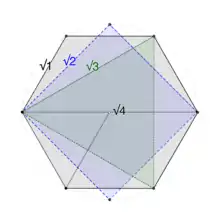
The 24 vertices of the 24-cell are distributed[8] at four different chord lengths from each other: √1, √2, √3 and √4.
Each vertex is joined to 8 others[lower-alpha 14] by an edge of length 1, spanning 60° = π/3 of arc. Next nearest are 6 vertices[lower-alpha 15] located 90° = π/2 away, along an interior chord of length √2. Another 8 vertices lie 120° = 2π/3 away, along an interior chord of length √3. The opposite vertex is 180° = π away along a diameter of length 2. Finally, as the 24-cell is radially equilateral, its center can be treated[lower-alpha 16] as a 25th canonical apex vertex,[lower-alpha 17] which is 1 edge length away from all the others.
To visualize how the interior polytopes of the 24-cell fit together (as described below), keep in mind that the four chord lengths (√1, √2, √3, √4) are the long diameters of the hypercubes of dimensions 1 through 4: the long diameter of the square is √2; the long diameter of the cube is √3; and the long diameter of the tesseract is √4.[lower-alpha 18] Moreover, the long diameter of the octahedron is √2 like the square; and the long diameter of the 24-cell itself is √4 like the tesseract.
Geodesics
The vertex chords of the 24-cell are arranged in geodesic great circles which lie in sets of orthogonal planes. The geodesic distance between two 24-cell vertices along a path of √1 edges is always 1, 2, or 3, and it is 3 only for opposite vertices.[lower-alpha 19]
The √1 edges occur in 16 hexagonal great circles (4 sets of 4 orthogonal[lower-alpha 11] planes), 4 of which cross at each vertex.[lower-alpha 21] The 96 distinct √1 edges divide the surface into 96 triangular faces and 24 octahedral cells: a 24-cell.
The √2 chords occur in 18 square great circles (3 sets of 6 orthogonal[lower-alpha 6] planes), 3 of which cross at each vertex.[lower-alpha 22] The 72 distinct √2 chords do not run in the same planes as the hexagonal great circles; they do not follow the 24-cell's edges, they pass through its octagonal cell centers.[lower-alpha 23]
The √3 chords occur in 32 triangular great circles in 16 planes (4 sets of 4 orthogonal planes),[lower-alpha 13] 4 of which cross at each vertex.[lower-alpha 24] The 96 distinct √3 chords run vertex-to-every-other-vertex in the same planes as the hexagonal great circles.[lower-alpha 12]
The √4 chords occur as 12 vertex-to-vertex diameters (3 sets of 4 orthogonal axes), the 24 radii around the 25th central vertex.[lower-alpha 17]
The √1 edges occur in 48 parallel pairs, √3 apart. The √2 chords occur in 36 parallel pairs, √2 apart. The √3 chords occur in 48 parallel pairs, √1 apart.[lower-alpha 25]
Each great circle plane intersects[lower-alpha 8] with each of the other great circle planes or face planes to which it is orthogonal at the center point only, and with each of the others to which it is not orthogonal at a single edge of some kind. In every case that edge is one of the vertex chords of the 24-cell.[lower-alpha 27]
Constructions
Triangles and squares come together uniquely in the 24-cell to generate, as interior features,[lower-alpha 16] all of the triangle-faced and square-faced regular convex polytopes in the first four dimensions (with caveats for the 5-cell and the 600-cell).[lower-alpha 28] Consequently, there are numerous ways to construct or deconstruct the 24-cell.
Reciprocal constructions from 8-cell and 16-cell
The 8 integer vertices (±1, 0, 0, 0) are the vertices of a regular 16-cell, and the 16 half-integer vertices (±1/2, ±1/2, ±1/2, ±1/2) are the vertices of its dual, the tesseract (8-cell). The tesseract gives Gosset's construction[11] of the 24-cell, equivalent to cutting a tesseract into 8 cubic pyramids, and then attaching them to the facets of a second tesseract. The analogous construction in 3-space gives the rhombic dodecahedron which, however, is not regular. The 16-cell gives the reciprocal construction of the 24-cell, Cesaro's construction,[12] equivalent to rectifying a 16-cell (truncating its corners at the mid-edges, as described above). The analogous construction in 3-space gives the cuboctahedron (dual of the rhombic dodecahedron) which, however, is not regular. The tesseract and the 16-cell are the only regular 4-polytopes in the 24-cell.[13]
We can further divide the 16 half-integer vertices into two groups: those whose coordinates contain an even number of minus (−) signs and those with an odd number. Each of these groups of 8 vertices also define a regular 16-cell. This shows that the vertices of the 24-cell can be grouped into three disjoint sets of eight with each set defining a regular 16-cell, and with the complement defining the dual tesseract.[14] This also shows that the symmetries of the 16-cell form a subgroup of index 3 of the symmetry group of the 24-cell.
Diminishings
We can facet the 24-cell by cutting[lower-alpha 29] through interior cells bounded by vertex chords to remove vertices, exposing the facets of interior 4-polytopes inscribed in the 24-cell. One can cut a 24-cell into two parts through any planar hexagon of 6 vertices, any planar rectangle of 4 vertices, or any triangle of 3 vertices. The great circle planes (above) are only some of those planes. Here we shall expose some of the others: the face planes[lower-alpha 30] of interior polytopes, which divide the 24-cell into two unequal parts.[lower-alpha 31]
8-cell
Starting with a complete 24-cell, remove 8 orthogonal vertices (4 opposite pairs on 4 perpendicular axes), and the 8 edges which radiate from each, by cutting through 8 cubic cells bounded by √1 edges to remove 8 cubic pyramids whose apexes are the vertices to be removed. This removes 4 edges from each hexagonal great circle (retaining just one opposite pair of edges), so no continuous hexagonal great circles remain. Now 3 perpendicular edges meet and form the corner of a cube at each of the 16 remaining vertices,[lower-alpha 32] and the 32 remaining edges divide the surface into 24 square faces and 8 cubic cells: a tesseract. There are three ways you can do this (choose a set of 8 orthogonal vertices out of 24), so there are three such tesseracts inscribed in the 24-cell. They overlap with each other, but most of their element sets are disjoint: they share some vertex count, but no edge length, face area, or cell volume. They do share 4-content, their common core.[lower-alpha 33]
16-cell
Starting with a complete 24-cell, remove the 16 vertices of a tesseract (retaining the 8 vertices you removed above), by cutting through 16 tetrahedral cells bounded by √2 chords to remove 16 tetrahedral pyramids whose apexes are the vertices to be removed. This removes 12 square great circles (retaining just one orthogonal set) and all the √1 edges, exposing √2 chords as the new edges. Now the remaining 6 square great circles cross perpendicularly, 3 at each of 8 remaining vertices,[lower-alpha 34] and their 24 edges divide the surface into 32 triangular faces and 16 tetrahedral cells: a 16-cell. There are three ways you can do this (remove 1 of 3 sets of tesseract vertices), so there are three such 16-cells inscribed in the 24-cell. They overlap with each other, but most of their element sets are disjoint: they do not share any vertex count, edge length, or face area, but they do share cell volume. They also share 4-content, their common core.[lower-alpha 33]
Tetrahedral constructions
The 24-cell can be constructed radially from 96 equilateral triangles of edge length √1 which meet at the center of the polytope, each contributing two radii and an edge.[lower-alpha 2] They form 96 √1 tetrahedra (each contributing one 24-cell face), all sharing the 25th central apex vertex. These form 24 octahedral pyramids (half-16-cells) with their apexes at the center.
The 24-cell can be constructed from 96 equilateral triangles of edge length √2, where the three vertices of each triangle are located 90° = π/2 away from each other. They form 48 √2 tetrahedra (the cells of the three 16-cells), centered at the 24 mid-radii of the 24-cell.
Relationships among interior polytopes
The 24-cell, three tesseracts, and three 16-cells are deeply entwined around their common center, and intersect in a common core.[lower-alpha 33] The tesseracts are inscribed in the 24-cell[lower-alpha 35] such that their vertices and edges are exterior elements of the 24-cell, but their square faces and cubical cells lie inside the 24-cell (they are not elements of the 24-cell). The 16-cells are inscribed in the 24-cell[lower-alpha 36] such that only their vertices are exterior elements of the 24-cell: their edges, triangular faces, and tetrahedral cells lie inside the 24-cell. The interior[lower-alpha 37] 16-cell edges have length √2.

The 16-cells are also inscribed in the tesseracts: their √2 edges are the face diagonals of the tesseract, and their 8 vertices occupy every other vertex of the tesseract. Each tesseract has two 16-cells inscribed in it (occupying the opposite vertices and face diagonals), so each 16-cell is inscribed in two of the three 8-cells. This is reminiscent of the way, in 3 dimensions, two tetrahedra can be inscribed in a cube, as discovered by Kepler.[15] In fact it is the exact dimensional analogy (the demihypercubes), and the 48 tetrahedral cells are inscribed in the 24 cubical cells in just that way.[16]
The 24-cell encloses the three tesseracts within its envelope of octahedral facets, leaving 4-dimensional space in some places between its envelope and each tesseract's envelope of cubes. Each tesseract encloses two of the three 16-cells, leaving 4-dimensional space in some places between its envelope and each 16-cell's envelope of tetrahedra. Thus there are measurable[4] 4-dimensional interstices[lower-alpha 38] between the 24-cell, 8-cell and 16-cell envelopes. The shapes filling these gaps are 4-pyramids,[lower-alpha 39] alluded to above.
Boundary cells
Despite the 4-dimensional interstices between 24-cell, 8-cell and 16-cell envelopes, their 3-dimensional volumes overlap. The different envelopes are separated in some places, and in contact in other places (where no 4-pyramid lies between them). Where they are in contact, they merge and share cell volume: they are the same 3-membrane in those places, not two separate but adjacent 3-dimensional layers.[lower-alpha 41] Because there are a total of 7 envelopes, there are places where several envelopes come together and merge volume, and also places where envelopes interpenetrate (cross from inside to outside each other).
Some interior features lie within the 3-space of the (outer) boundary envelope of the 24-cell itself: each octahedral cell is bisected by three perpendicular squares (one from each of the tesseracts), and the diagonals of those squares (which cross each other perpendicularly at the center of the octahedron) are 16-cell edges (one from each 16-cell). Each square bisects an octahedron into two square pyramids, and also bonds two adjacent cubic cells of a tesseract together as their common face.
As we saw above, 16-cell √2 tetrahedral cells are inscribed in tesseract √1 cubic cells, sharing the same volume. 24-cell √1 octahedral cells overlap their volume with √1 cubic cells: they are bisected by a square face into two square pyramids,[17] the apexes of which also lie at a vertex of a cube.[lower-alpha 42] The octahedra share volume not only with the cubes, but with the tetrahedra inscribed in them; thus the 24-cell, tesseracts, and 16-cells all share some boundary volume.[lower-alpha 40]
As a configuration
This configuration matrix[18] represents the 24-cell. The rows and columns correspond to vertices, edges, faces, and cells. The diagonal numbers say how many of each element occur in the whole 24-cell. The non-diagonal numbers say how many of the column's element occur in or at the row's element.
Since the 24-cell is self-dual, its matrix is identical to its 180 degree rotation.
Symmetries, root systems, and tessellations

The 24 root vectors of the D4 root system of the simple Lie group SO(8) form the vertices of a 24-cell. The vertices can be seen in 3 hyperplanes,[lower-alpha 43] with the 6 vertices of an octahedron cell on each of the outer hyperplanes and 12 vertices of a cuboctahedron on a central hyperplane. These vertices, combined with the 8 vertices of the 16-cell, represent the 32 root vectors of the B4 and C4 simple Lie groups.
The 48 vertices (or strictly speaking their radius vectors) of the union of the 24-cell and its dual form the root system of type F4. The 24 vertices of the original 24-cell form a root system of type D4; its size has the ratio √2:1. This is likewise true for the 24 vertices of its dual. The full symmetry group of the 24-cell is the Weyl group of F4, which is generated by reflections through the hyperplanes orthogonal to the F4 roots. This is a solvable group of order 1152. The rotational symmetry group of the 24-cell is of order 576.
Quaternionic interpretation
When interpreted as the quaternions, the F4 root lattice (which is the integral span of the vertices of the 24-cell) is closed under multiplication and is therefore a ring. This is the ring of Hurwitz integral quaternions. The vertices of the 24-cell form the group of units (i.e. the group of invertible elements) in the Hurwitz quaternion ring (this group is also known as the binary tetrahedral group). The vertices of the 24-cell are precisely the 24 Hurwitz quaternions with norm squared 1, and the vertices of the dual 24-cell are those with norm squared 2. The D4 root lattice is the dual of the F4 and is given by the subring of Hurwitz quaternions with even norm squared.
Vertices of other convex regular 4-polytopes also form multiplicative groups of quaternions, but few of them generate a root lattice.
Voronoi cells
The Voronoi cells of the D4 root lattice are regular 24-cells. The corresponding Voronoi tessellation gives the tessellation of 4-dimensional Euclidean space by regular 24-cells, the 24-cell honeycomb. The 24-cells are centered at the D4 lattice points (Hurwitz quaternions with even norm squared) while the vertices are at the F4 lattice points with odd norm squared. Each 24-cell of this tessellation has 24 neighbors. With each of these it shares an octahedron. It also has 24 other neighbors with which it shares only a single vertex. Eight 24-cells meet at any given vertex in this tessellation. The Schläfli symbol for this tessellation is {3,4,3,3}. It is one of only three regular tessellations of R4.
The unit balls inscribed in the 24-cells of this tessellation give rise to the densest known lattice packing of hyperspheres in 4 dimensions. The vertex configuration of the 24-cell has also been shown to give the highest possible kissing number in 4 dimensions.
Radially equilateral honeycomb
The dual tessellation of the 24-cell honeycomb {3,4,3,3} is the 16-cell honeycomb {3,3,4,3}. The third regular tessellation of four dimensional space is the tesseractic honeycomb {4,3,3,4}, whose vertices can be described by 4-integer Cartesian coordinates. The congruent relationships among these three tessellations can be helpful in visualizing the 24-cell, in particular the radial equilateral symmetry which it shares with the tesseract.[lower-alpha 2]
A honeycomb of unit-edge-length 24-cells may be overlaid on a honeycomb of unit-edge-length tesseracts such that every vertex of a tesseract (every 4-integer coordinate) is also the vertex of a 24-cell (and tesseract edges are also 24-cell edges), and every center of a 24-cell is also the center of a tesseract.[21] The 24-cells are twice as large as the tesseracts by 4-dimensional content (hypervolume), so overall there are two tesseracts for every 24-cell, only half of which are inscribed in a 24-cell. If those tesseracts are colored black, and their adjacent tesseracts (with which they share a cubical facet) are colored red, a 4-dimensional checkerboard results.[22] Of the 24 center-to-vertex radii[lower-alpha 44] of each 24-cell, 16 are also the radii of a black tesseract inscribed in the 24-cell. The other 8 radii extend outside the black tesseract (through the centers of its cubical facets) to the centers of the 8 adjacent red tesseracts. Thus the 24-cell honeycomb and the tesseractic honeycomb coincide in a special way: 8 of the 24 vertices of each 24-cell do not occur at a vertex of a tesseract (they occur at the center of a tesseract instead). Each black tesseract is cut from a 24-cell by truncating it at these 8 vertices, slicing off 8 cubic pyramids (as in reversing Gosset's construction,[11] but instead of being removed the pyramids are simply colored red and left in place). Eight 24-cells meet at the center of each red tesseract: each one meets its opposite at that shared vertex, and the six others at a shared octahedral cell.
The red tesseracts are filled cells (they contain a central vertex and radii); the black tesseracts are empty cells. The vertex set of this union of two honeycombs includes the vertices of all the 24-cells and tesseracts, plus the centers of the red tesseracts. Adding the 24-cell centers (which are also the black tesseract centers) to this honeycomb yields a 16-cell honeycomb, the vertex set of which includes all the vertices and centers of all the 24-cells and tesseracts. The formerly empty centers of adjacent 24-cells become the opposite vertices of a unit-edge-length 16-cell. 24 half-16-cells (octahedral pyramids) meet at each formerly empty center to fill each 24-cell, and their octahedral bases are the 6-vertex octahedral facets of the 24-cell (shared with an adjacent 24-cell).
Rotations
There are three distinct orientations of the tesseractic honeycomb which could be made to coincide with the 24-cell honeycomb in this manner, depending on which of the 24-cell's three disjoint sets of 8 orthogonal vertices (which set of 4 perpendicular axes) was chosen to align it, just as three tesseracts can be inscribed in the 24-cell, rotated with respect to each other. The distance from one of these orientations to another is an isoclinic rotation through 60 degrees (a double rotation of 60 degrees in each pair of orthogonal axes planes, around a single fixed point).[lower-alpha 47]</ref> This rotation can be seen most clearly in the hexagonal central planes, where the hexagon rotates to change which of its three diameters is aligned with a coordinate system axis.[lower-alpha 10]
Projections
Parallel projections

The vertex-first parallel projection of the 24-cell into 3-dimensional space has a rhombic dodecahedral envelope. Twelve of the 24 octahedral cells project in pairs onto six square dipyramids that meet at the center of the rhombic dodecahedron. The remaining 12 octahedral cells project onto the 12 rhombic faces of the rhombic dodecahedron.
The cell-first parallel projection of the 24-cell into 3-dimensional space has a cuboctahedral envelope. Two of the octahedral cells, the nearest and farther from the viewer along the w-axis, project onto an octahedron whose vertices lie at the center of the cuboctahedron's square faces. Surrounding this central octahedron lie the projections of 16 other cells, having 8 pairs that each project to one of the 8 volumes lying between a triangular face of the central octahedron and the closest triangular face of the cuboctahedron. The remaining 6 cells project onto the square faces of the cuboctahedron. This corresponds with the decomposition of the cuboctahedron into a regular octahedron and 8 irregular but equal octahedra, each of which is in the shape of the convex hull of a cube with two opposite vertices removed.
The edge-first parallel projection has an elongated hexagonal dipyramidal envelope, and the face-first parallel projection has a nonuniform hexagonal bi-antiprismic envelope.
Perspective projections
The vertex-first perspective projection of the 24-cell into 3-dimensional space has a tetrakis hexahedral envelope. The layout of cells in this image is similar to the image under parallel projection.
The following sequence of images shows the structure of the cell-first perspective projection of the 24-cell into 3 dimensions. The 4D viewpoint is placed at a distance of five times the vertex-center radius of the 24-cell.
| Cell-first perspective projection | ||
|---|---|---|
 In this image, the nearest cell is rendered in red, and the remaining cells are in edge-outline. For clarity, cells facing away from the 4D viewpoint have been culled. |
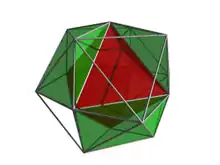 In this image, four of the 8 cells surrounding the nearest cell are shown in green. The fourth cell is behind the central cell in this viewpoint (slightly discernible since the red cell is semi-transparent). |
 Finally, all 8 cells surrounding the nearest cell are shown, with the last four rendered in magenta. |
| Note that these images do not include cells which are facing away from the 4D viewpoint. Hence, only 9 cells are shown here. On the far side of the 24-cell are another 9 cells in an identical arrangement. The remaining 6 cells lie on the "equator" of the 24-cell, and bridge the two sets of cells. | ||
 Stereographic projection |
 A 3D projection of a 24-cell performing a simple rotation. | |
 Animated cross-section of 24-cell |
||
 A stereoscopic 3D projection of an icositetrachoron (24-cell). | ||
Isometric Orthogonal Projection of: 8 Cell(Tesseract) + 16 Cell = 24 Cell | ||
Orthogonal projections
| Coxeter plane | F4 | |
|---|---|---|
| Graph | 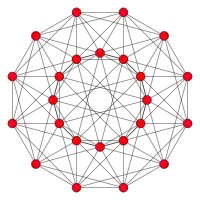 | |
| Dihedral symmetry | [12] | |
| Coxeter plane | B3 / A2 (a) | B3 / A2 (b) |
| Graph |  |
 |
| Dihedral symmetry | [6] | [6] |
| Coxeter plane | B4 | B2 / A3 |
| Graph |  |
 |
| Dihedral symmetry | [8] | [4] |
Visualization
The 24-cell is bounded by 24 octahedral cells. For visualization purposes, it is convenient that the octahedron has opposing parallel faces (a trait it shares with the cells of the tesseract and the 120-cell). One can stack octahedrons face to face in a straight line bent in the 4th direction into a great circle with a circumference of 6 cells. The cell locations lend themselves to a hyperspherical description. Pick an arbitrary cell and label it the "North Pole". Eight great circle meridians (two cells long) radiate out in 3 dimensions, converging at the 3rd "South Pole" cell. This skeleton accounts for 18 of the 24 cells (2 + 8×2). See the table below.
There is another related great circle in the 24-cell, the dual of the one above. A path that traverses 6 vertices solely along edges resides in the dual of this polytope, which is itself since it is self dual. These are the hexagonal geodesics described above. One can easily follow this path in a rendering of the equatorial cuboctahedron cross-section.
Starting at the North Pole, we can build up the 24-cell in 5 latitudinal layers. With the exception of the poles, each layer represents a separate 2-sphere, with the equator being a great 2-sphere. The cells labeled equatorial in the following table are interstitial to the meridian great circle cells. The interstitial "equatorial" cells touch the meridian cells at their faces. They touch each other, and the pole cells at their vertices. This latter subset of eight non-meridian and pole cells has the same relative position to each other as the cells in a tesseract (8-cell), although they touch at their vertices instead of their faces.
| Layer # | Number of Cells | Description | Colatitude | Region |
|---|---|---|---|---|
| 1 | 1 cell | North Pole | 0° | Northern Hemisphere |
| 2 | 8 cells | First layer of meridian cells | 60° | |
| 3 | 6 cells | Non-meridian / interstitial | 90° | Equator |
| 4 | 8 cells | Second layer of meridian cells | 120° | Southern Hemisphere |
| 5 | 1 cell | South Pole | 180° | |
| Total | 24 cells | |||

The 24-cell can be partitioned into disjoint sets of four of these 6-cell great circle rings, forming a discrete Hopf fibration of four interlocking rings.[23] One ring is "vertical", encompassing the pole cells and four meridian cells. The other three rings each encompass two equatorial cells and four meridian cells, two from the northern hemisphere and two from the southern.
Note this hexagon great circle path implies the interior/dihedral angle between adjacent cells is 180 - 360/6 = 120 degrees. This suggests you can adjacently stack exactly three 24-cells in a plane and form a 4-D honeycomb of 24-cells as described previously.
One can also follow a great circle route, through the octahedrons' opposing vertices, that is four cells long. These are the square geodesics along four √2 chords described above. This path corresponds to traversing diagonally through the squares in the cuboctahedron cross-section. The 24-cell is the only regular polytope in more than two dimensions where you can traverse a great circle purely through opposing vertices (and the interior) of each cell. This great circle is self dual. This path was touched on above regarding the set of 8 non-meridian (equatorial) and pole cells. The 24-cell can be equipartitioned into three 8-cell subsets, each having the organization of a tesseract. Each of these subsets can be further equipartitioned into two interlocking great circle chains, four cells long. Collectively these three subsets now produce another, six ring, discrete Hopf fibration.
Three Coxeter group constructions
There are two lower symmetry forms of the 24-cell, derived as a rectified 16-cell, with B4 or [3,3,4] symmetry drawn bicolored with 8 and 16 octahedral cells. Lastly it can be constructed from D4 or [31,1,1] symmetry, and drawn tricolored with 8 octahedra each.
| Three nets of the 24-cell with cells colored by D4, B4, and F4 symmetry | |||||||||||
|---|---|---|---|---|---|---|---|---|---|---|---|
| Rectified demitesseract | Rectified 16-cell | Regular 24-cell | |||||||||
| D4, [31,1,1], order 192 | B4, [3,3,4], order 384 | F4, [3,4,3], order 1152 | |||||||||
 | |||||||||||
| Three sets of 8 rectified tetrahedral cells | One set of 16 rectified tetrahedral cells and one set of 8 octahedral cells. | One set of 24 octahedral cells | |||||||||
| Vertex figure (Each edge corresponds to one triangular face, colored by symmetry arrangement) | |||||||||||
 |
 |
 | |||||||||
Related complex polygons
The regular complex polygon 4{3}4, ![]()
![]()
![]() or
or ![]()
![]()
![]() contains the 24 vertices of the 24-cell, and 24 4-edges that correspond to central squares of 24 of 48 octahedral cells. Its symmetry is 4[3]4, order 96.[24]
contains the 24 vertices of the 24-cell, and 24 4-edges that correspond to central squares of 24 of 48 octahedral cells. Its symmetry is 4[3]4, order 96.[24]
The regular complex polytope 3{4}3, ![]()
![]()
![]() or
or ![]()
![]()
![]() , in has a real representation as a 24-cell in 4-dimensional space. 3{4}3 has 24 vertices, and 24 3-edges. Its symmetry is 3[4]3, order 72.
, in has a real representation as a 24-cell in 4-dimensional space. 3{4}3 has 24 vertices, and 24 3-edges. Its symmetry is 3[4]3, order 72.
| Name | {3,4,3}, |
4{3}4, |
3{4}3, |
|---|---|---|---|
| Symmetry | [3,4,3], |
4[3]4, |
3[4]3, |
| Vertices | 24 | 24 | 24 |
| Edges | 96 2-edges | 24 4-edge | 24 3-edges |
| Image |  24-cell in F4 Coxeter plane, with 24 vertices in two rings of 12, and 96 edges. |
 4{3}4, |
 3{4}3 or |
Related 4-polytopes
Several uniform 4-polytopes can be derived from the 24-cell via truncation:
- truncating at 1/3 of the edge length yields the truncated 24-cell;
- truncating at 1/2 of the edge length yields the rectified 24-cell;
- and truncating at half the depth to the dual 24-cell yields the bitruncated 24-cell, which is cell-transitive.
The 96 edges of the 24-cell can be partitioned into the golden ratio to produce the 96 vertices of the snub 24-cell. This is done by first placing vectors along the 24-cell's edges such that each two-dimensional face is bounded by a cycle, then similarly partitioning each edge into the golden ratio along the direction of its vector. An analogous modification to an octahedron produces an icosahedron, or "snub octahedron."
The 24-cell is the unique convex self-dual regular Euclidean polytope that is neither a polygon nor a simplex. Relaxing the condition of convexity admits two further figures: the great 120-cell and grand stellated 120-cell. With itself, it can form a polytope compound: the compound of two 24-cells.
Related uniform polytopes
| D4 uniform polychora | |||||||||||
|---|---|---|---|---|---|---|---|---|---|---|---|
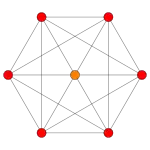 |
 |
 |
 |
 |
 |
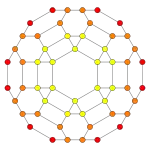 |
 | ||||
| {3,31,1} h{4,3,3} |
2r{3,31,1} h3{4,3,3} |
t{3,31,1} h2{4,3,3} |
2t{3,31,1} h2,3{4,3,3} |
r{3,31,1} {31,1,1}={3,4,3} |
rr{3,31,1} r{31,1,1}=r{3,4,3} |
tr{3,31,1} t{31,1,1}=t{3,4,3} |
sr{3,31,1} s{31,1,1}=s{3,4,3} | ||||
| 24-cell family polytopes | |||||||||||
|---|---|---|---|---|---|---|---|---|---|---|---|
| Name | 24-cell | truncated 24-cell | snub 24-cell | rectified 24-cell | cantellated 24-cell | bitruncated 24-cell | cantitruncated 24-cell | runcinated 24-cell | runcitruncated 24-cell | omnitruncated 24-cell | |
| Schläfli symbol |
{3,4,3} | t0,1{3,4,3} t{3,4,3} |
s{3,4,3} | t1{3,4,3} r{3,4,3} |
t0,2{3,4,3} rr{3,4,3} |
t1,2{3,4,3} 2t{3,4,3} |
t0,1,2{3,4,3} tr{3,4,3} |
t0,3{3,4,3} | t0,1,3{3,4,3} | t0,1,2,3{3,4,3} | |
| Coxeter diagram |
|||||||||||
| Schlegel diagram |
 |
 |
 |
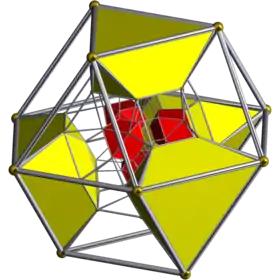 |
 |
 |
 |
 |
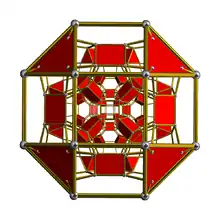 |
 | |
| F4 |  |
 |
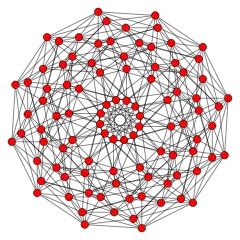 |
 |
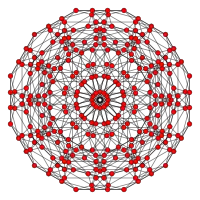 |
 |
 |
 |
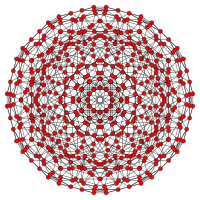 |
 | |
| B4 |  |
 |
 |
 |
 |
 |
 |
 |
 |
 | |
| B3(a) |  |
 |
 |
 |
 |
 |
 |
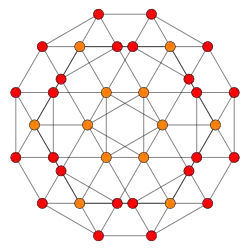 |
 |
 | |
| B3(b) |  |
 |
 |
 |
 |
 | |||||
| B2 |  |
 |
 |
 |
 |
 |
 |
 |
 |
 | |
The 24-cell can also be derived as a rectified 16-cell:
| B4 symmetry polytopes | |||||||||||
|---|---|---|---|---|---|---|---|---|---|---|---|
| Name | tesseract | rectified tesseract |
truncated tesseract |
cantellated tesseract |
runcinated tesseract |
bitruncated tesseract |
cantitruncated tesseract |
runcitruncated tesseract |
omnitruncated tesseract | ||
| Coxeter diagram |
= |
= |
|||||||||
| Schläfli symbol |
{4,3,3} | t1{4,3,3} r{4,3,3} |
t0,1{4,3,3} t{4,3,3} |
t0,2{4,3,3} rr{4,3,3} |
t0,3{4,3,3} | t1,2{4,3,3} 2t{4,3,3} |
t0,1,2{4,3,3} tr{4,3,3} |
t0,1,3{4,3,3} | t0,1,2,3{4,3,3} | ||
| Schlegel diagram |
 |
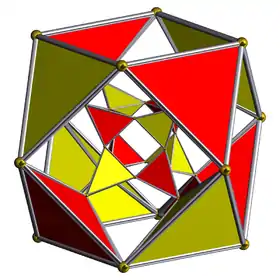 |
 |
 |
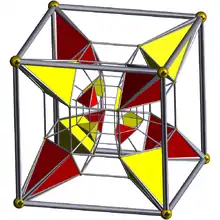 |
 |
 |
 |
 | ||
| B4 |  |
 |
 |
 |
 |
 |
 |
 |
 | ||
| Name | 16-cell | rectified 16-cell |
truncated 16-cell |
cantellated 16-cell |
runcinated 16-cell |
bitruncated 16-cell |
cantitruncated 16-cell |
runcitruncated 16-cell |
omnitruncated 16-cell | ||
| Coxeter diagram |
= |
= |
= |
= |
= |
= |
|||||
| Schläfli symbol |
{3,3,4} | t1{3,3,4} r{3,3,4} |
t0,1{3,3,4} t{3,3,4} |
t0,2{3,3,4} rr{3,3,4} |
t0,3{3,3,4} | t1,2{3,3,4} 2t{3,3,4} |
t0,1,2{3,3,4} tr{3,3,4} |
t0,1,3{3,3,4} | t0,1,2,3{3,3,4} | ||
| Schlegel diagram |
 |
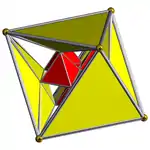 |
 |
 |
 |
 |
 |
 |
 | ||
| B4 |  |
 |
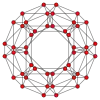 |
 |
 |
 |
 |
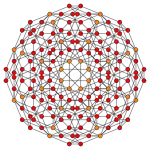 |
 | ||
| {3,p,3} polytopes | |||||||||||
|---|---|---|---|---|---|---|---|---|---|---|---|
| Space | S3 | H3 | |||||||||
| Form | Finite | Compact | Paracompact | Noncompact | |||||||
| {3,p,3} | {3,3,3} | {3,4,3} | {3,5,3} | {3,6,3} | {3,7,3} | {3,8,3} | ... {3,∞,3} | ||||
| Image |  |
 |
 |
 |
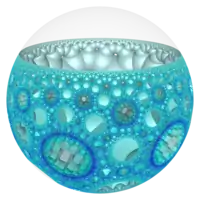 |
 |
 | ||||
| Cells |  {3,3} |
 {3,4} |
 {3,5} |
 {3,6} |
 {3,7} |
 {3,8} |
 {3,∞} | ||||
| Vertex figure |
 {3,3} |
 {4,3} |
 {5,3} |
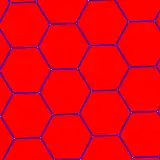 {6,3} |
 {7,3} |
 {8,3} |
 {∞,3} | ||||
Notes
- The 24-cell is one of only three self-dual regular Euclidean polytopes which are neither a polygon nor a simplex. The other two are also 4-polytopes, but not convex: the grand stellated 120-cell and the great 120-cell.
- The long radius (center to vertex) of the 24-cell is equal to its edge length; thus its long diameter (vertex to opposite vertex) is 2 edge lengths. Only a few uniform polytopes have this property, including the four-dimensional 24-cell and tesseract, the three-dimensional cuboctahedron, and the two-dimensional hexagon. (The cuboctahedron is the equatorial cross section of the 24-cell, and the hexagon is the equatorial cross section of the cuboctahedron.) Radially equilateral polytopes are those which can be constructed, with their long radii, from equilateral triangles which meet at the center of the polytope, each contributing two radii and an edge.
- The convex regular polytopes in the first four dimensions with a 5 in their Schlӓfli symbol are the pentagon {5}, the dodecahedron {5, 3}, the 600-cell {3,3,5} and the 120-cell {5,3,3}. In other words, the 24-cell possesses all of the triangular and square features that exist in four dimensions except the regular 5-cell, but none of the pentagonal features.
- The convex regular 4-polytopes can be ordered by size as a measure of 4-dimensional content (hypervolume) for the same radius. Each greater polytope in the sequence is rounder than its predecessor, enclosing more content[4] within the same radius. The 4-simplex (5-cell) is the limit smallest case, and the 120-cell is the largest. Complexity (as measured by comparing configuration matrices or simply the number of vertices) follows the same ordering. This provides an alternative numerical naming scheme for regular polytopes in which the 24-cell is the 24-point 4-polytope: fourth in the ascending sequence that runs from 5-point 4-polytope to 600-point 4-polytope.
- The edge length will always be different unless predecessor and successor are both radially equilateral, i.e. their edge length is the same as their radius (so both are preserved). Since radially equilateral polytopes[lower-alpha 2] are rare, it seems that the only such construction (in any dimension) is from the 8-cell to the 24-cell, making the 24-cell the unique regular polytope (in any dimension) which has the same edge length as its predecessor of the same radius.
- Up to 6 planes can be mutually orthogonal in 4 dimensions. 3 dimensional space accommodates only 3 perpendicular axes and 3 perpendicular planes through a single point. In 4 dimensional space we may have 4 perpendicular axes and 6 perpendicular planes through a point (for the same reason that the tetrahedron has 6 edges, not 4): there are 6 ways to take 4 dimensions 2 at a time. Three such pairs (perpendicular planes) meet at each vertex (for the same reason that three edges of the tetrahedron meet at each vertex).
- The edges of the squares are aligned with the grid lines of this coordinate system. For example:
( 0,–1, 1, 0) ( 0, 1, 1, 0)
( 0,–1,–1, 0) ( 0, 1,–1, 0)
is the square in the xy plane. The edges of the squares are not 24-cell edges, they are interior chords joining two vertices 90o distant from each other; so the squares are merely invisible configurations of four of the 24-cell's vertices, not visible 24-cell features. - Two planes in 4-dimensional space can have four possible reciprocal positions: (1) they can coincide (be exactly the same plane); (2) they can be parallel (the only way they can fail to intersect at all); (3) they can intersect in a single line, as two non-parallel planes do in 3-dimensional space; or (4) they can intersect in a single point: and they must, if and only if they are completely[lower-alpha 26] perpendicular; this is the surprising, counterintuitive thing about how planes intersect in 4-space.
- The edges of the orthogonal equatorial squares are not aligned with the grid lines of the unit radius coordinate system. The squares do lie in the 6 orthogonal planes of the coordinate system, but their edges are the √2 diagonals of unit-edge-length squares of the coordinate lattice. For example:
( 0, 0, 1, 0)
( 0,–1, 0, 0) ( 0, 1, 0, 0)
( 0, 0,–1, 0)
is the square in the xy plane. Notice that the 8 integer coordinates comprise the vertices of the 6 orthogonal squares. - The perpendicular hexagons are inclined (tilted) with respect to the unit radius coordinate system's orthogonal planes. Each plane contains only one of the 4 coordinate system axes. The hexagon consists of 3 pairs of opposite vertices (three 24-cell diameters): one opposite pair of integer coordinate vertices (one of the four coordinate axes), and two opposite pairs of half-integer coordinate vertices (not coordinate axes). For example:
( 0, 0, 1, 0)
( 1/2,–1/2, 1/2,–1/2) ( 1/2, 1/2, 1/2, 1/2)
(–1/2,–1/2,–1/2,–1/2) (–1/2, 1/2,–1/2, 1/2)
( 0, 0,–1, 0)
is a hexagon on the y axis. Unlike the √2 squares, the hexagons are actually made of 24-cell edges, so they are visible features of the 24-cell. - It is of course difficult to visualize four hexagonal planes that are all perpendicular to each other. One can see them in the cuboctahedron (a projection of the 24-cell into 3-dimensions), where they appear to be at 60 degrees to each other. In the 3 dimensional projection two of 4 non-orthogonal hexagons appear to intersect at each of 12 vertices, but these are actually 16 hexagons and 24 vertices. In 4 dimensions, 4 non-orthogonal hexagons do intersect at each vertex, but also four orthogonal hexagons intersect only at their common center, such that each one of them passes through a disjoint set of 6 of the 24 vertices.
- These triangles lie in the same orthogonal planes containing the hexagons;[lower-alpha 10] two triangles of edge length √3 are inscribed in each hexagon. For example, in unit radius coordinates:
( 0, 0, 1, 0)
( 1/2,–1/2, 1/2,–1/2) ( 1/2, 1/2, 1/2, 1/2)
(–1/2,–1/2,–1/2,–1/2) (–1/2, 1/2,–1/2, 1/2)
( 0, 0,–1, 0)
are two opposing central triangles on the y axis, with each triangle formed by the vertices in alternating rows. Unlike the hexagons, the √3 triangles are not made of actual 24-cell edges, so they are invisible features of the 24-cell, like the √2 squares. - These are not the orthogonal planes of the coordinate system; these triangles' edges of length √3 are the diagonals of cubical cells of unit edge length found within the 24-cell, but those cubical (tesseract) cells are not aligned with the unit radius coordinate lattice.
- They surround the vertex (in the 3-dimensional space of the 24-cell's boundary surface) the way a cube's 8 corners surround its center. (The vertex figure of the 24-cell is a cube.)
- They surround the vertex in 3-dimensional space the way an octahedron's 6 corners surround its center.
- Interior features are not considered elements of the polytope. For example, the center of a 24-cell is a noteworthy feature (as are its long radii), but these interior features do not count as elements in its configuration matrix, which counts only elementary features (which are not interior to any other feature including the polytope itself). Interior features are not rendered in most of the diagrams and illustrations in this article (they are normally invisible). In illustrations showing interior features, we always draw interior edges as dashed lines, to distinguish them from elementary edges.
- The central vertex is a canonical apex because it is one edge length equidistant from the ordinary vertices in the 4th dimension, as the apex of a canonical pyramid is one edge length equidistant from its other vertices.
- Thus (√1, √2, √3, √4) are the vertex chord lengths of the tesseract as well as of the 24-cell. They are also the diameters of the tesseract (from short to long), though not of the 24-cell.
- If the Pythagorean distance between any two vertices is √1, their geodesic distance is 1; they may be two adjacent vertices (in the curved 3-space of the surface), or a vertex and the center (in 4-space). If their Pythagorean distance is √2, their geodesic distance is 2 (whether via 3-space or 4-space, because the path along the edges is the same straight line with one 90o bend in it as the path through the center). If their Pythagorean distance is √3, their geodesic distance is still 2 (whether on a hexagonal great circle past one 60o bend, or as a straight line with one 60o bend in it through the center). Finally, if their Pythagorean distance is √4, their geodesic distance is still 2 in 4-space (straight through the center), but it reaches 3 in 3-space (by going halfway around a hexagonal great circle).
- The vertex figure is the facet which is made by truncating a vertex; canonically, at the mid-edges incident to the vertex. But one can make similar vertex figures of different radii by truncating at any point along those edges, up to and including truncating at the adjacent vertices to make a full size vertex figure. That is what serves the illustrative purpose here.
- Eight √1 edges converge in 3-dimensional space from the corners of the 24-cell's cubical vertex figure[lower-alpha 20] and meet at its center (the vertex), where they form 4 straight lines which cross there. The 8 vertices of the cube are the eight nearest other vertices of the 24-cell. The straight lines are geodesics: two √1-length segments of an apparently straight line (in the 3-space of the 24-cell's curved surface) that is bent in the 4th dimension into a great circle hexagon (in 4-space). Imagined from inside this curved 3-space, the bends in the hexagons are invisible. From outside (if we could view the 24-cell in 4-space), the straight lines would be seen to bend in the 4th dimension at the cube centers, because the center is displaced outward in the 4th dimension, out of the hyperplane defined by the cube's vertices. Thus the vertex cube is actually a cubic pyramid.
- Six √2 chords converge in 3-space from the face centers of the 24-cell's cubical vertex figure[lower-alpha 20] and meet at its center (the vertex), where they form 3 straight lines which cross there perpendicularly. The 8 vertices of the cube are the eight nearest other vertices of the 24-cell, and eight √1 edges converge from there, but let us ignore them now, since 7 straight lines crossing at the center is confusing to visualize all at once. Each of the six √2 chords runs from this cube's center (the vertex) through a face center to the center of an adjacent (face-bonded) cube, which is another vertex of the 24-cell: not a nearest vertex (at the cube corners), but one located 90° away in a second concentric shell of six √2-distant vertices that surrounds the first shell of eight √1-distant vertices. The face-center through which the √2 chord passes is the mid-point of the √2 chord, so it lies inside the 24-cell.
- One can cut the 24-cell into two equal parts through 6 vertices (in any hexagonal great circle plane), or through 4 vertices (in any square great circle plane). One can see this in the cuboctahedron (the central hyperplane of the 24-cell), where there are four hexagonal great circles (along the edges) and six square great circles (across the square faces diagonally).
- Eight √3 chords converge from the corners of the 24-cell's cubical vertex figure[lower-alpha 20] and meet at its center (the vertex), where they form 4 straight lines which cross there. Each of the eight √3 chords runs from this cube's center to the center of a diagonally adjacent (vertex-bonded) cube, which is another vertex of the 24-cell: one located 120° away in a third concentric shell of eight √3-distant vertices surrounding the second shell of six √2-distant vertices that surrounds the first shell of eight √1-distant vertices.
- Each pair of parallel √1 edges joins a pair of parallel √3 chords to form one of 48 rectangles, and each pair of parallel √2 chords joins another pair of parallel √2 chords to form one of 18 squares.
- Two flat planes A and B of a Euclidean space of four dimensions are called completely orthogonal if and only if every line in A is orthogonal to every line in B. In that case the planes A and B intersect at a single point O, so that if a line in A intersects with a line in B, they intersect at O.
- Each great circle plane intersects with the other great circle planes to which it is not orthogonal at one √4 diameter of the 24-cell. Thus two non-orthogonal squares or hexagons share two opposing vertices, unlike two orthogonal great circle polygons which share no points except their common center. Two non-orthogonal great circle triangles share only one vertex, since they lack opposing vertices.
- The 600-cell is larger than the 24-cell, and contains the 24-cell as an interior feature.[9] The regular 5-cell is not found in the interior of any convex regular 4-polytope except the 120-cell,[10] though every 4-polytope can be deconstructed into irregular 5-cells.
- We can cut a vertex off a polygon with a 0-dimensional cutting instrument (like the point of a knife, or the head of a zipper) by sweeping it along a 1-dimensional line, exposing a new edge. We can cut a vertex off a polyhedron with a 1-dimensional cutting edge (like a knife) by sweeping it through a 2-dimensional face plane, exposing a new face. We can cut a vertex off a polychoron (a 4-polytope) with a 2-dimensional cutting plane (like a snowplow), by sweeping it through a 3-dimensional cell volume, exposing a new cell. Notice that as within the new edge length of the polygon or the new face area of the polyhedron, every point within the new cell volume is now exposed on the surface of the polychoron.
- Each cell face plane intersects with the other face planes of its kind to which it is not completely orthogonal or parallel at their characteristic vertex chord edge. It may seem paradoxical that adjacent face planes of orthogonally-faced cells (such as cubes) intersect at an edge (as they obviously do), since planes are not supposed to be able to intersect in 4-space (except at a single point) if they are completely orthogonal.[lower-alpha 8] The resolution of this apparent paradox is that adjacent face planes of such 4-polytope cells are not completely[lower-alpha 26] orthogonal in 4-space. Although their dihedral angle is 90 degrees in the boundary 3-space, they lie in the same hyperplane (they are coincident rather than perpendicular in the fourth dimension); thus they intersect in a line, as non-parallel planes do in any 3-space.
- The only planes through exactly 6 vertices of the 24-cell (not counting the central vertex) are the 16 hexagonal great circles. There are no planes through exactly 5 vertices. There are several kinds of planes through exactly 4 vertices: the 18 √2 square great circles, the 72 √1 square (tesseract) faces, and 144 √1 by √2 rectangles. The planes through exactly 3 vertices are the 96 √2 equilateral triangle (16-cell) faces, and the 96 √1 equilateral triangle (24-cell) faces.
- The 24-cell's cubical vertex figure[lower-alpha 20] has been truncated to a tetrahedral vertex figure (see Kepler's drawing). The vertex cube has vanished, and now there are only 4 corners of the vertex figure where before there were 8. Four tesseract edges converge from the tetrahedron vertices and meet at its center, where they do not cross (since the tetrahedron does not have opposing vertices).
- The common core is the 24-cell's insphere-inscribed dual 24-cell of edge length and radius 1/2. Rectifying any of the three 16-cells reveals this smaller 24-cell, which has a 4-content of only 1/8 (1/16 that of the 24-cell). Its vertices lie at the centers of the 24-cell's octahedral cells, which are also the centers of the tesseracts' square faces, and are also the centers of the 16-cells' edges.
- The 24-cell's cubical vertex figure[lower-alpha 20] has been truncated to an octahedral vertex figure. The vertex cube has vanished, and now there are only 6 corners of the vertex figure where before there were 8. The 6 √2 chords which formerly converged from cube face centers now converge from octahedron vertices; but just as before, they meet at the center where 3 straight lines cross perpendicularly. The octahedron vertices are located 90° away outside the vanished cube, at the new nearest vertices; before truncation those were 24-cell vertices in the second shell of surrounding vertices.
- The 24 vertices of the 24-cell, each used twice, are the vertices of three 16-vertex tesseracts.
- The 24 vertices of the 24-cell, each used once, are the vertices of three 8-vertex 16-cells.
- The edges of the 16-cells are not shown in any of the renderings in this article; if we wanted to show interior edges, they could be drawn as dashed lines. The edges of the inscribed tesseracts are always visible, because they are also edges of the 24-cell.
- The 4-dimensional content of the unit-edge-length tesseract is 1 (by definition). The content of the unit-edge-length 24-cell is 2, so half its content is inside each tesseract, and half is between their envelopes. Each 16-cell (edge length √2) encloses a content of 2/3, leaving 1/3 of an enclosing tesseract between their envelopes.
- Between the 24-cell envelope and the 8-cell envelope, we have the 8 cubic pyramids of Gosset's construction. Between the 8-cell envelope and the 16-cell envelope, we have 16 right tetrahedral pyramids, with their apexes filling the corners of the tesseract.
- Consider the three perpendicular √2 long diameters of the octahedral cell. Two of them are the face diagonals of the square face between two cubes; each is a √2 chord that connects two vertices of those 8-cell cubes across a square face, connects two vertices of two 16-cell tetrahedra (inscribed in the cubes), and connects two opposite vertices of a 24-cell octahedron (diagonally across two of the three orthogonal square central sections). The third perpendicular long diameter of the octahedron does exactly the same (by symmetry); so it also connects two vertices of a pair of cubes across their common square face (but a different pair of cubes, from one of the other tesseracts in the 24-cell).
- Because there are three overlapping tesseracts inscribed in the 24-cell, each octahedral cell lies on a cubic cell of one tesseract (in the cubic pyramid based on the cube, but not in the cube's volume), and in two cubic cells of the other two tesseracts (which it spans, sharing their volume).[lower-alpha 40]
- This might appear at first to be angularly impossible, and indeed it would be in a flat space of only three dimensions. If two cubes rest face-to-face in an ordinary 3-dimensional space (e.g. on the surface of a table in an ordinary 3-dimensional room), an octahedron will fit inside them such that four of its six vertices are at the four corners of the square face between the two cubes; but then the other two octahedral vertices will not lie at a cube corner (they will fall within the volume of the two cubes, but not at a cube vertex). In four dimensions, this is no less true! The other two octahedral vertices do not lie at the corner of the adjacent face-bonded cube in the same tesseract. However, in the 24-cell there is not just one inscribed tesseract (of 8 cubes), there are three overlapping tesseracts (of 8 cubes each). The other two octahedral vertices do lie at the corner of a cube: but a cube in another (overlapping) tesseract.[lower-alpha 41]
- One way to visualize the n-dimensional hyperplanes is as the n-spaces which can be defined by n + 1 points. A point is the 0-space which is defined by 1 point. A line is the 1-space which is defined by 2 points which are not coincident. A plane is the 2-space which is defined by 3 points which are not colinear (any triangle). In 4-space, a 3-dimensional hyperplane is the 3-space which is defined by 4 points which are not coplanar (any tetrahedron). In 5-space, a 4-dimensional hyperplane is the 4-space which is defined by 5 points which are not cocellular (any 5-cell). These simplex figures divide the hyperplane into two parts (inside and outside the figure), but in addition they divide the universe (the enclosing space) into two parts (above and below the hyperplane). The n points bound a finite simplex figure (from the outside), and they define an infinite hyperplane (from the inside).[20] These two divisions are orthogonal, so the defining simplex divides space into six regions: inside the simplex and in the hyperplane, inside the simplex but above or below the hyperplane, outside the simplex but in the hyperplane, and outside the simplex above or below the hyperplane.
- It is important to visualize the radii only as invisible interior features of the 24-cell (dashed lines), since they are not edges of the honeycomb. Similarly, the center of the 24-cell is empty (not a vertex of the honeycomb).
- Three dimensional rotations occur around an axis line. Four dimensional rotations may occur around a plane. So in three dimensions we may fold planes around a common line (as when folding a flat net of 6 squares up into a cube), and in four dimensions we may fold cells around a common plane (as when folding a flat net of 8 cubes up into a tesseract). Folding around a square face is just folding around two of its orthogonal edges at the same time; there is not enough space in three dimensions to do this, just as there is not enough space in two dimensions to fold around a line (only enough to fold around a point).
- There are (at least) two kinds of correct dimensional analogies: the usual kind between dimension n and dimension n + 1, and the much rarer and less obvious kind between dimension n and dimension n + 2. An example of the latter is that rotations in 4-space may take place around a single point, as do rotations in 2-space. Another is the n-sphere rule that the surface area of the sphere embedded in n+2 dimensions is exactly 2π r times the volume enclosed by the sphere embedded in n dimensions, the most well-known examples being that the circumference of a circle is 2π r times 1, and the surface area of the ordinary sphere is 2π r times 2r. Coxeter cites<ref name='FOOTNOTECoxeter1973119§7.1. Dimensional Analogy'>Coxeter 1973, p. 119, §7.1. Dimensional Analogy: "For instance, seeing that the circumference of a circle is 2π r, while the surface of a sphere is 4π r 2, ... it is unlikely that the use of analogy, unaided by computation, would ever lead us to the correct expression, 2π 2r 3."
- Rotations in four dimensions may occur around a plane, as when adjacent cells are folded around their plane of intersection (by analogy to the way adjacent faces are folded around their line of intersection).[lower-alpha 45] But in four dimensions there is yet another way in which rotations can occur, called a double rotation. Double rotations are an emergent phenomenon in the fourth dimension and have no analogy in three dimensions: folding up square faces and folding up cubical cells are both examples of simple rotations, the only kind that occur in fewer than four dimensions. In 3-dimensional rotations, the points in a line remain fixed during the rotation, while every other point moves. In 4-dimensional simple rotations, the points in a plane remain fixed during the rotation, while every other point moves. In 4-dimensional double rotations, a point remains fixed during rotation, and every other point moves (as in a 2-dimensional rotation!). This is one of several surprising, counter-intuitive things about rotations in 4-space.[lower-alpha 46] this as an instance in which dimensional analogy can fail us as a method, but it is really our failure to recognize whether a one- or two-dimensional analogy is the appropriate method.
Citations
- Coxeter 1973, p. 118, Chapter VII: Ordinary Polytopes in Higher Space.
- Johnson 2018, p. 249, 11.5.
- Ghyka 1977, p. 68.
- Coxeter 1973, pp. 292-293, Table I(ii): The sixteen regular polytopes {p,q,r} in four dimensions: [An invaluable table providing all 20 metrics of each 4-polytope in edge length units. They must be algebraically converted to compare polytopes of unit radius.]
- Coxeter 1973, p. 302, Table VI (ii): 𝐈𝐈 = {3,4,3}: see Result column
- Coxeter 1973, p. 156, §8.7. Cartesian Coordinates.
- Coxeter 1973, pp. 145-146, §8.1 The simple truncations of the general regular polytope.
- Coxeter 1973, p. 298, Table V: The Distribution of Vertices of Four-Dimensional Polytopes in Parallel Solid Sections (§13.1); (i) Sections of {3,4,3} (edge 2) beginning with a vertex; see column a.
- Coxeter 1973, p. 153, 8.5. Gosset's construction for {3,3,5}: "In fact, the vertices of {3,3,5}, each taken 5 times, are the vertices of 25 {3,4,3}'s."
- Coxeter 1973, p. 304, Table VI(iv) II={5,3,3}: Faceting {5,3,3}[120𝛼4]{3,3,5} of the 120-cell reveals 120 regular 5-cells.
- Coxeter 1973, p. 150, Gosset.
- Coxeter 1973, p. 148, §8.2. Cesaro's construction for {3, 4, 3}..
- Coxeter 1973, p. 302, Table VI(ii) II={3,4,3}, Result column.
- Coxeter 1973, pp. 149-150, §8.22. see illustrations Fig. 8.2A and Fig 8.2B
- Kepler 1619, p. 181.
- Coxeter 1973, p. 269, §14.32. "For instance, in the case of ...."
- Coxeter 1973, p. 150: "Thus the 24 cells of the {3, 4, 3} are dipyramids based on the 24 squares of the . (Their centres are the mid-points of the 24 edges of the .)"
- Coxeter 1973, p. 12, §1.8. Configurations.
- van Ittersum 2020, pp. 73-79, §4.2.
- Coxeter 1973, p. 120, §7.2.: "... any n+1 points which do not lie in an (n-1)-space are the vertices of an n-dimensional simplex.... Thus the general simplex may alternatively be defined as a finite region of n-space enclosed by n+1 hyperplanes or (n-1)-spaces."
- Coxeter 1973, p. 163: Coxeter notes that Gosset was apparently the first to remark that the cells of the 24-cell honeycomb {3,4,3,3} are concentric with alternate cells of the tesseractic honeycomb {4,3,3,4}, and that this observation enabled Gosset's method of construction of the complete set of regular polytopes and honeycombs.
- Coxeter 1973, p. 156: "...the chess-board has an n-dimensional analogue."
- Banchoff 2013, pp. 265-266.
- Coxeter 1991.
References
- Kepler, Johannes (1619). Harmonices Mundi (The Harmony of the World). Johann Planck.
- Banchoff, Thomas F. (2013). "Torus Decompostions of Regular Polytopes in 4-space". In Senechal, Marjorie (ed.). Shaping Space. Springer New York. pp. 257–266. doi:10.1007/978-0-387-92714-5_20. ISBN 978-0-387-92713-8.
- Coxeter, H.S.M. (1973) [1948]. Regular Polytopes (3rd ed.). New York: Dover.
- Coxeter, H.S.M. (1991), Regular Complex Polytopes (2nd ed.), Cambridge: Cambridge University Press
- Coxeter, H.S.M. (1995), Sherk, F. Arthur; McMullen, Peter; Thompson, Anthony C.; Weiss, Asia Ivic (eds.), Kaleidoscopes: Selected Writings of H.S.M. Coxeter (2nd ed.), Wiley-Interscience Publication, ISBN 978-0-471-01003-6
- (Paper 22) H.S.M. Coxeter, Regular and Semi Regular Polytopes I, [Math. Zeit. 46 (1940) 380-407, MR 2,10]
- (Paper 23) H.S.M. Coxeter, Regular and Semi-Regular Polytopes II, [Math. Zeit. 188 (1985) 559-591]
- (Paper 24) H.S.M. Coxeter, Regular and Semi-Regular Polytopes III, [Math. Zeit. 200 (1988) 3-45]
- Ghyka, Matila (1977). The Geometry of Art and Life. New York: Dover Publications. ISBN 978-0-486-23542-4.
- Johnson, Norman (2018), Geometries and Transformations, Cambridge: Cambridge University Press, ISBN 978-1-107-10340-5
- Johnson, Norman (1991), Uniform Polytopes (Manuscript ed.)
- Johnson, Norman (1966), The Theory of Uniform Polytopes and Honeycombs (Ph.D. ed.)
- Weisstein, Eric W. "24-Cell". MathWorld. (also under Icositetrachoron)
- Klitzing, Richard. "4D uniform polytopes (polychora) x3o4o3o - ico".
- Olshevsky, George. "Icositetrachoron". Glossary for Hyperspace. Archived from the original on 4 February 2007.
- Der 24-Zeller (24-cell) Marco Möller's Regular polytopes in R4 (German)
- van Ittersum, Clara (2020). "Symmetry groups of regular polytopes in three and four dimensions". TUDelft.
External links
- 24-cell animations
- 24-cell in stereographic projections
- 24-cell description and diagrams
- Petrie dodecagons in the 24-cell: mathematics and animation software

